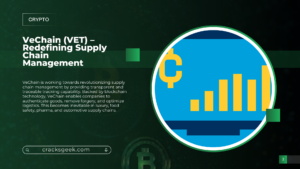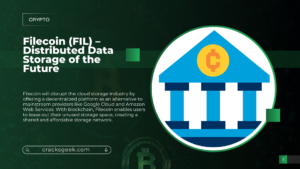
Cryptocurrency has moved past hype, and investors are now focusing on projects with real-world applications. Real-world use case altcoins—anything from supply chains and banking to energy efficiency and medicine—are being taken seriously. These projects have the potential to shake up traditional industries and deliver real utility rather than hype.
Below are some of the altcoins whose applications in the real world render them interesting to astute investors:
1. Chainlink (LINK) – Connecting Smart Contracts and Real-World Data
Chainlink is a decentralized oracular network that enables smart contracts to communicate with the outside world. Blockchains lack an intrinsic means of accessing external data sources beyond their own chain, and as such, they have limited uses. Chainlink solves this problem by providing secure and reliable smart contract data feeds and is critical in supply chain, insurance, and decentralized finance (DeFi) applications.
From DeFi lending protocol price feeds to weather data for parametric insurance, Chainlink has become the crypto ecosystem‘s infrastructure backbone. With increasing businesses and blockchain builders utilizing it, LINK continues to be a strong contender as a long-term investment opportunity.
2. Stellar (XLM) – Inexpensive and Rapid Cross-Border Payments
Stellar is a blockchain that enables cheap and instant cross-border payments, and thus ideal for remittances and financial inclusion. Compared to traditional bank systems with expensive and slow intermediaries, Stellar enables money transfer nearly in real time at low cost.
Through its connection with the payment processors and financial institutions, Stellar has become a portal in mainstream finance for blockchain technology. With increasing regulatory demand for remittance products on blockchain, Stellar’s XLM token will be increasingly utilized in cross-border transactions.
3. VeChain (VET) – Redefining Supply Chain Management

VeChain is working towards revolutionizing supply chain management by providing transparent and traceable tracking capability. Backed by blockchain technology, VeChain enables companies to authenticate goods, remove forgery, and optimize logistics. This becomes inevitable in luxury, food safety, pharma, and automotive supply chains.
Giant businesses such as Walmart China and BMW have piloted VeChain’s solutions to achieve optimal supply chain efficiency. Blockchain’s immutable ledger, VeChain makes it possible for companies and consumers to authenticate products, defeating counterfeiting and building trust.
4. Hedera (HBAR) – Energy-Efficient and Scalable Blockchain Technology
Hedera Hashgraph is an open public network with fast transactions, low cost fees, and low-energy-proof-of-service consensus protocol. It is not a proof-of-work blockchain or a proof-of-stake blockches as it involves another “gossip about gossip” consensus protocol to quickly agree and secure.
This positions Hedera in a position of strength for commercial adoption with firms looking for green scalable blockchain solutions. Inter-industry collaboration, including health care, finance, and digital identity, makes Hedera’s HBAR token the one that will reign supreme among future decentralized apps.
5. Algorand (ALGO) – Smart Contracts for Green and Scalable Use
Algorand is a fast, secure, and sustainable blockchain platform. Featuring a pure proof-of-stake consensus algorithm, Algorand minimizes energy usage without losing high transaction velocity. It is therefore a financially appealing choice for financial services, gaming, and dApps-based initiatives.
Algorand’s second greatest strength is being environment-conscious, and governments and corporations seeking a green alternative for blockchain will be overjoyed to hear about something like it. Blockchain will go on evolving more with DeFi, NFTs, and CBDCs, and Algorand will certainly be pioneering what can be done in blockchain.
6. Cardano (ADA) – A Science-Based Approach towards Blockchain Innovation
Cardano stands out for its emphasis on scientific experimentation and peer-reviewed development. Other blockchain projects hurry to market, but Cardano follows a methodical approach to guarantee security and scalability. Its multi-layered architecture separates the settlement layer (for payments) from the computation layer (for smart contracts) to offer flexibility and efficiency.
With its focus on functional application—such as Africa’s digital identity and unbanked financial services—Cardano keeps building a solid ecosystem. As increasing smart contract capabilities, ADA’s future in the long run is extremely rosy.
7. Filecoin (FIL) – Distributed Data Storage of the Future

Filecoin will disrupt the cloud storage industry by offering a decentralized platform as an alternative to mainstream providers like Google Cloud and Amazon Web Services. With blockchain, Filecoin enables users to lease out their unused storage space, creating a shared and affordable storage network.
Such decentralized architecture offers protection of data, reduced reliance on centralized companies, and the means to offer censorship-resistant storage networks. With continuing increasing demand for decentralized cloud services, Filecoin’s FIL token will have more usage in the online storage industry.
Conclusion
The cryptocurrency world is shifting away from speculation and towards projects providing real-world value being the new norm. Investors today are beginning to look into altcoins that provide real solutions, providing real-use cases in finance, supply chain, and data storage worlds.
Altcoins like Chainlink, Stellar, VeChain, Hedera, Algorand, Cardano, and Filecoin are not hype coins—these are the future of blockchain adoption. By investing in these projects, smart investors can position themselves for success down the line in the digital economy.





